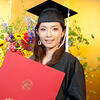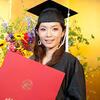You mentioned in your graduation speech that study at TUJ was very tough.
In the initial general education courses I studied many things that seemed at first to be totally unrelated to art and I think that was probably the toughest time. Of course, once the specialist courses began the classes were not all about creating artworks, I had to study many other things including the history of art. Through research, writing papers and making presentations I feel that I really learned a lot. My commute to university took two hours each way and I tried to use those four hours of travelling as effectively as possible. With my mind set on getting closer to my goal of graduate school, I feel that I worked to clear each semester, one at a time.
Now that you have gained a degree from a U.S. university, how do you intend to utilize that qualification in your future career?
As we are now in a time when it is becoming natural, even in Japan, to communicate in English, I think it is a tremendous advantage to have learned real English that I can use. Also, if I can earn a post-graduate degree from a Japanese institution in the future, I will have the advantage of having degrees from two countries, the U.S. and Japan.
Now that I have been fortunate enough to graduate, I am trying to decide in what form I can continue my studies. I have been asked whether I want to find a job, but I do not intend on becoming a standard company employee. Once I have gained a further degree, I hope to find a teaching job or research position that would enable me to remain in graduate school where I could engage in work that involves interaction with other people. I am also, of course, thinking about going overseas again.




